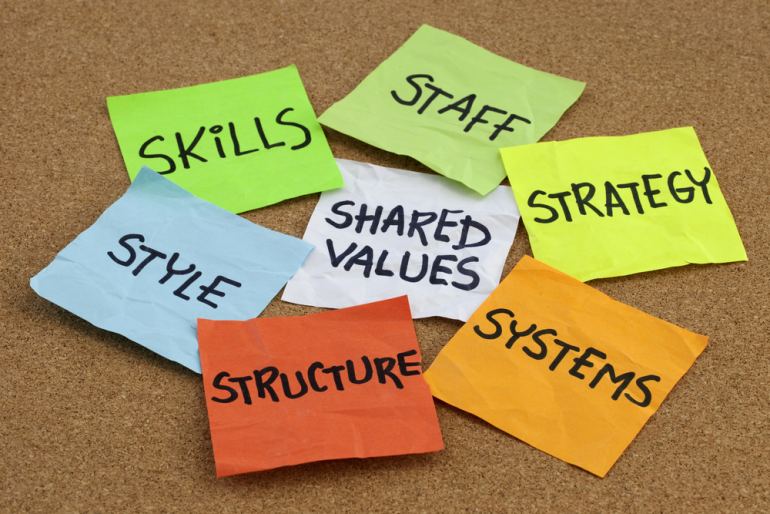
Enhancing Organizational Success: A Deep Dive into the McKinsey 7S Model with Real-Life Case Studies
Currently, organizations face constant challenges in learning new marketing approaches, consistently devising impactful campaigns that make a mark and grow. Successful companies understand that the key to sustainable growth lies in aligning their internal elements effectively. One powerful tool that has proven its value in achieving organizational success is the McKinsey 7S Model. Developed by McKinsey & Company, this strategic management framework examines seven critical interdependent factors within an organization to create a cohesive and high-performing unit.
So let’s delve into the McKinsey 7S Model, explore each element in detail, and illustrate its practical application through real-life case studies.
Strategy:
The first S in the McKinsey 7S Model represents the organization's overarching plan and direction. A clear and well-defined marketing strategy is essential to guide decision-making, resource allocation, and market positioning. A prime example is Apple Inc., which revolutionized the technology industry by focusing on innovation, creating premium products, and building a strong brand identity. Their strategic approach has enabled them to consistently outperform competitors and dominate the market.
Structure:
The second S denotes the organization's design, including its hierarchy and reporting lines. A cohesive marketing team structure facilitates efficient communication, collaboration, and decision-making. Procter & Gamble (P&G) serves as a prime example. P&G's matrix organizational structure enables seamless coordination between various brands and functions, fostering innovation and global expansion.
Systems:
The third S in the model refers to the processes and procedures that support the execution of the marketing strategy. Amazon, renowned for its customer-centric approach, leverages robust systems to streamline operations, ensuring fast and reliable product delivery and an outstanding customer experience. Their efficient system integration has driven unparalleled growth and customer loyalty.
Skills:
The fourth S encompasses the competencies and expertise of the marketing team. Adobe, a leading software company, continuously invests in its employees' development, ensuring they possess the skills required to innovate and deliver exceptional customer experiences. This focus on upskilling has contributed to their industry-leading solutions and sustained growth.
Staff:
The fifth S highlights the importance of having the right people in the right roles. Google is renowned for its rigorous talent acquisition process, seeking individuals who align with their culture of innovation and passion for solving complex challenges. This meticulous approach to hiring has fostered a dynamic and diverse workforce that drives Google's continuous success.
Style:
The sixth S relates to the leadership and management style that influences an organization's culture and decision-making. Microsoft's transformation under Satya Nadella exemplifies effective leadership. His inclusive and empowering style enabled Microsoft to shift its focus from products to solutions, leading to unprecedented growth and market relevance.
Shared Values:
The final S represents the core values and beliefs that underpin the organization's identity. Starbucks, known for its commitment to social responsibility and ethical sourcing, has successfully cultivated a brand that resonates with its customers' values. This shared value system has resulted in a loyal customer base and global brand advocacy.
Case Studies:
General Electric (GE):
GE implemented the McKinsey 7S Model during its organizational transformation. By aligning strategy, structure, systems, skills, staff, style, and shared values, GE refocused on core competencies and divested non-core businesses. This strategic shift resulted in increased operational efficiency, improved financial performance, and enhanced shareholder value.
Coca-Cola:
Coca-Cola utilized the McKinsey 7S Model to streamline its marketing function. By reevaluating its marketing strategy, restructuring marketing teams, and investing in employee development, Coca-Cola achieved greater agility in responding to market trends and enhancing customer engagement.
Real-life case studies, like General Electric and Coca-Cola, demonstrate the McKinsey 7S Model’s practical application in driving transformation and achieving long-term success. The model has surely provided organizations with a comprehensive framework to evaluate and align their internal elements in a super effective way. By harmonizing strategy, structure, systems, skills, staff, style, and shared values, companies are now creating a unified and high-performing entity. If you are striving to make your mark with data-driven marketing strategies that are on-point, engaging and relatable, consider outsourcing your marketing needs to a reliable partner like Marketing Eye Atlanta.
At Marketing Eye Atlanta, we pride ourselves on being truly disruptive in every way. We're not your typical marketing agency – we're a force of change, committed to helping businesses thrive. Our outsourced marketing model is tailor-made for companies that recognize the power of having a 'Marketing Eye' on their side. Through collaboration and partnership, we believe there are no limits to what we can achieve together – and our track record proves it! Check out our services to know how we are constantly evolving and developing custom technology to work harder, faster, and smarter for our clients, ensuring remarkable results.



Leave a comment
Make sure you enter all the required information, indicated by an asterisk (*). HTML code is not allowed.